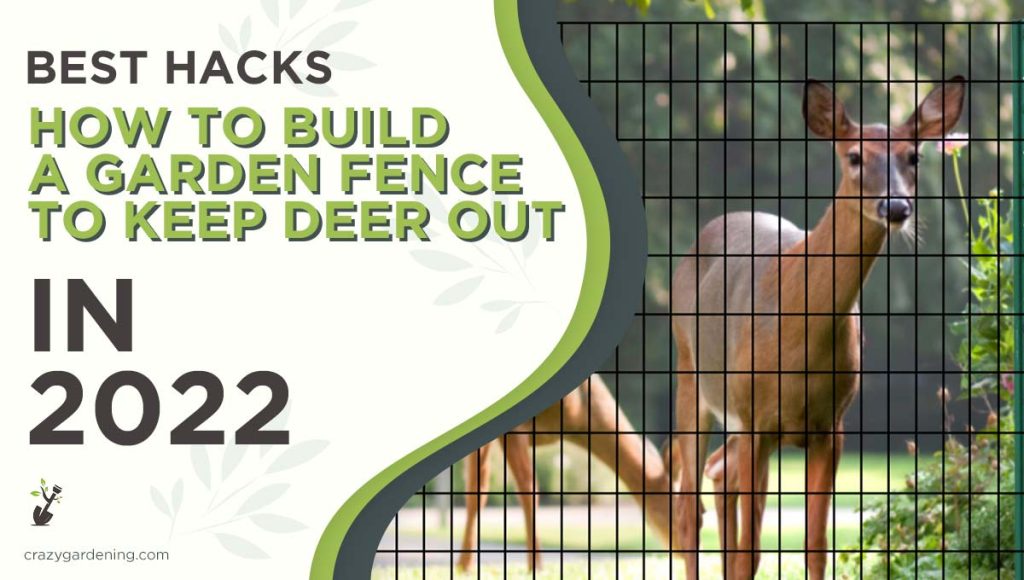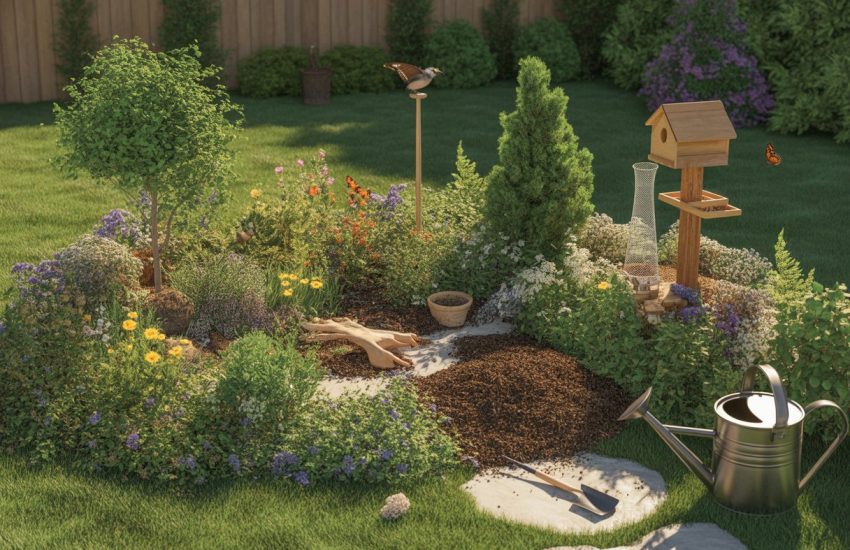Build a Cheap and Easy Deer Proof Garden Fence [Guide 2025]
Are you looking for a way to keep deer out of your garden? A fence is a great way to do that, and it doesn’t have to be expensive or difficult to build.
Deer create many problems for you, like eating your garden, harming your flowers, and just generally being a nuisance.
While there are many ways to keep deer away from your property, building a fence is one of the most effective methods.
In this blog post, we’ll show you how to build a simple garden fence that will keep deer out. We’ll also give you some tips on choosing the right materials and getting started. So, read on for all the details!

Why Do You Need a Garden Fence?
There are many reasons why you might need a garden fence. Maybe you live in an area with a lot of deer, or perhaps you just want to keep your garden safe from animals.
Either way, a fence is a great way to protect your plants and flowers. There are several benefits to having a fence around your garden, including:
* Keeping deer out
* Keeping other animals out
* Protecting your plants from damage
* Giving you privacy
Other than garden fence you can also use some types of deer replents that protect your garden plants from deers.
What are the types of garden fences used to keep deer out?
When it comes to choosing a garden fence, there are many options available. The type of fence you choose will depend on your budget, the look you want to achieve, and how much protection you need.
Some of the most popular types of garden fences include:
Wood fences
A wood fence is a type of garden fence that is made from, you guessed it, wood! Wood fences are a popular choice because they are relatively inexpensive and easy to install.
Plus, they offer a natural look that can be stained or painted to match your home.
Vinyl fences
Vinyl fences are another popular choice for garden fences. They are made from PVC plastic and are available in a variety of colors and styles.
Vinyl fences are durable and low-maintenance, making them a great option for busy homeowners.
Woven wire fences
Woven wire fences are also a popular choice for garden fences. They are made from metal wire that is woven together to create a strong, sturdy fence.
Woven wire fences are often used to keep small animals out of gardens, as they are not strong enough to keep deer out.
Aluminum fences
Aluminum fences are a good choice if you’re looking for a durable, long-lasting fence. They are also available in a variety of styles and can be powder coated to match your home’s exterior.
Electric fences
Electric fences are a great option if you’re looking for a fence that will keep deer out.
Electric fences work by providing a mild shock to animals that come into contact with them, deterring them from entering your property.
Build a Cheap and Easy Deer Proof Garden Fence
Now that you know why you need a garden fence and what types of fences are available, it’s time to learn how to build one! Building a garden fence is a relatively simple project that can be completed on a weekend.
To build a garden fence, you will need some type of materials are as follows:
**Fence posts**: Fence posts are used to support the fence. And then you can make it from a variety of materials, including wood, metal, and plastic.
**Fence panels**: Fence panels are the horizontal boards that make up the fence. They can be made from a variety of materials, including wood, vinyl, and metal.
**A fence gate** is a door that allows you to enter and exit the fenced area. Gates can be made from a variety of materials, including wood, vinyl, and metal.
**Fence hardware**: Fence hardware is used to attach the fence panels to the posts. It can be made from a variety of materials, including steel, aluminum, and brass.
**Gravel**: will help to prevent animals from digging under the fence.
**Concrete**: Concrete will help to keep the fence in place and protect the plants from the animals so that they can’t dig under it.
**A Posthole Digger**: A posthole digger is a tool that is used to dig holes for fence posts.
**A Shovel:** A shovel is a tool that will be used for weeding and planting your vegetables, and you can use it effectively.
With everything gathered, you’re ready to start building your fence!
Select The Area for the Fence
Select the area for the fence and mark it off with stakes and string. This will help you visualize the size and location of the fence. By selecting a perfect area for fence, this makes you very easy and tension free about the safety of your plants and property.
Dig Holes
The first step is to dig the post holes. Using a post hole digger, dig holes that are at least 2 feet deep and 2 feet wide. Once all of the holes have been dug, you can begin to set the posts.
Fill Holes with Concrete
For wooden posts, set them in the holes and then fill the holes with concrete. For metal or plastic posts, set them in the holes and then fill the holes with gravel.
The gravel will help to keep the posts in place and prevent animals from digging under the fence.
Add Fence Panels
Next, it’s time to add the fence panels. Depending on the type of fence you’re building, you may need to attach the panels to the posts with brackets or screws.
Once all of the panels are in place, you can add the gate (if desired).
Fit Gaps with Gravel
Finally, you will need to fill in any gaps between the fence panels and posts with gravel. This will help to prevent animals from digging under the fence.
Once the gravel is in place, you can pour concrete around the base of the posts to keep the fence in place and protect the plants from animals that try to dig under it.
With your fence completed, you can now enjoy your garden without having to worry about deer getting in and destroying your hard work!
And after building fence you want to make it higher then you get help by our article about making fence taller.
Tips and Tricks for Deer-Proofing Garden Fence
Choose deer-resistant garden plants.
One of the best ways to keep deer out of your garden is to choose plants that they don’t like to eat.
There are a variety of deer-resistant plants available, like fuzzy or hairy foliage, heavily fragranced foliage, prickly foliage, toxic foliage, grasses, and more, so do some research to find the ones that will work best for your garden.
Put up the right kind of garden deer fence.
The type of fence you choose will play a big role in keeping deer out of your garden.
A tall fence (at least 8 feet) is necessary to keep deer from jumping over, and the fence should be made of material that they cannot see through or easily push down.
All metal, PVC, or wooden fencing are all good choices for a deer fence. Make sure the fence is in good repair because even the best fence won’t do its job if it’s not in good condition.
Using deer repellents religiously!
Deer repellents can be effective in keeping deer out of your garden, but you need to use them correctly and be consistent for them to work.
There are a variety of deer repellents available on the market, including those that contain predator urine, ammonium soaps, hot pepper sprays, and more.
Be sure to choose a deer repellent that is safe for use around humans and pets, and how to use it carefully for getting the required results.
Deter deer by scaring them off
If you have deer in your garden, sometimes the best way to keep them out is to scare them off.
There are a variety of devices available that can be used to deter deer, like motion-activated sprinklers, ultrasonic devices, and more.
Easy Gardener Deer Barrier
Easy Gardener Deer Barrier is a type of deer fencing that is designed to keep deer out of gardens and other areas where they are not welcome.
It is made from a durable, UV-protected polypropylene material that is resistant to tearing and is available in various sizes.
It can be installed using stakes or posts and is easy to cut to fit any size garden or landscape.
Conclusion
Building a fence is a great way to keep deer out of your garden. There are a variety of options available, and the type of fence you choose will depend on your budget and needs.
You can build a fence for keeping any type of animals away from your garden easily.
Electric fences are an effective option, but they can be costly. Wood, vinyl, and metal fences are less expensive options that will still protect from deer.
Regardless of the type of fence you choose, be sure to fill in any gaps with gravel and pour concrete around the fence in place to prevent animals from digging under it.
With your fence in place, you can now enjoy your garden without worry.
FAQs
Question
What is the best fencing to keep deer out of garden?
Answer
The best fencing to keep deer out of a garden is a 7-8 foot high fence made of sturdy materials like metal or wood, with mesh openings no larger than 4 inches.
Question
What smells repel deer?
Answer
Scents that repel deer include human hair, soaps, and commercial sprays containing putrescent egg solids, garlic, and hot pepper. Some people also use the scent of predator urine such as coyote urine to repel deer.
Question
What can I put on my fence to keep deer out?
Answer
You can put deer netting, repellent sprays, or strips of aluminum foil or cloth soaked in scent deterrents like garlic or predator urine on your fence to keep deer out.
Question
How high should a fence be to keep deer away?
Answer
A deer proof fence should be at least 8 feet tall to be effective. Some experts recommend a height of 8-10 feet for maximum effectiveness. The fence should also extend at least 6 inches below ground level to prevent deer from digging under it.
Question
What scares deer away from gardens?
Answer
Deer repellents such as human hair, soaps, or commercial sprays that contain putrescent egg solids, hot pepper or garlic oil can be effective. Motion-activated sprinklers or lights, and noise-making devices like radios can also help. Physical barriers like 8-10 ft high fence is most effective.
Question
how to build a deer proof garden fence?
Answer
Build a fence at least 8 feet tall, extend it at least 6 inches underground and use materials such as mesh, wire, or wood.

